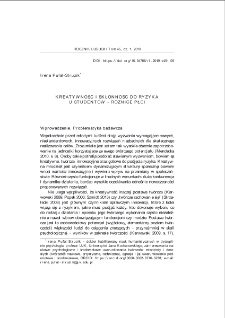Digital Library of Zielona Góra contains 9 272 digital objects
Object
Title: Kreatywność i skłonność do ryzyka u studentów - różnice płci = Creativity and students` propensity to risk-taking - differences between the genders
Contributor:
Group publication title:
Abstract_pl:
Normą współczesności stała się konieczność przekraczania granic przez człowieka i zbiorowości ludzkie, dokonywania transgresji w poszukiwaniu nowych, niestandardowych, innowacyjnych rozwiązań. Natomiast immanentną cechą współczesnych działań trangresyjnych jest ryzyko, do którego zdolny jest człowiek będący podmiotem innowacyjnym, o postawie twórczej, samodzielnym. W artykule przedstawiono rezultaty badania kreatywności i skłonności do ryzyka u studentów (n = 116) i studentek (n = 101). Zastosowano dwa testy psychologiczne: Kwestionariusz Twórczego Zachowania KANH I S. Popka służący do pomiaru postawy twórczej bądź odtwórczej oraz Test Zachowań Ryzykownych (TZR) R. Studenskiego. ; Celem badania jest odpowiedź na pytanie: Czy występuje i jaką siłę ma związek między postawą twórczą (kreatywnością) i skłonnością do ryzyka u studentów? Czy są różnice płci w postawie twórczej studentów oraz w gotowości do działań ryzykownych? Badanie wykazało - zgodnie z przewidywaniami wyprowadzonymi z literatury przedmiotu - że osoby kreatywne częściej podejmują ryzyko, zwłaszcza jeśli są to mężczyźni. Dyskutowane są zarówno teoretyczne, jak i praktyczne konsekwencje tych ustaleń.
Abstract:
The necessity of border crossing and transgression in search for new, non-standard, and innovative solutions have become a norm of modernity. On the other hand, modern transgression activities are immanently characterized by risk, a feature typical of independent, creative, and innovative people. The article presents the results of the study on creativity and risk propensity in male (n = 116) and female students (n = 101). Two psychological tests were used: The Creative Behaviour Questionnaire CBQ I (Kwestionariusz Twórczego Zachowania KANH I) by Popek, used to measure creative or re-creative attitude, and the Risky Behaviour Test (Test Zachowań Ryzykownych - TZR) by Studenski. ; The aim of the study was to answer the question: Does it occur and what is the relationship between the creative attitude (creativity) and the risk-taking attitude in students? Are there differences between both genders regarding students? creative attitude and their readiness to engage in risky activities? The study showed, in accordance with the predictions based on the literature, that creative people are more likely to take risks, especially if they are men. Both theoretical and practical consequences of these findings were discussed.
Publisher:
Zielona Góra: Lubuskie Towarzystwo Naukowe ; Zielona Góra: Uniwersytet Zielonogórski, Wydział Pedagogiki, Psychologii i Socjologii
Format:
Resource Identifier:
DOI:
Pages:
Source:
Rocznik Lubuski, tom 45, część 1
Language:
Rights:
Biblioteka Uniwersytetu Zielonogórskiego
Object collections:
- Repository > Faculties > Faculty of Education, Psychology and Sociology
- Repository > Types of work > Articles
- Repository > Scientific journals and UZ publishing series > Lubuski Yearbook
Last modified:
Jun 14, 2024
In our library since:
Jun 14, 2024
Number of object content hits:
198
All available object's versions:
https://zbc.uz.zgora.pl/repozytorium/publication/89344
Show description in RDF format:
Show description in OAI-PMH format:
Objects Similar
Kozaryn, Maciej Wasilewski, Wiesław Moczulska, Marta - red. Preston, Peter- red. jęz. Stankiewicz, Janina - red. nacz. Zmyślony, Roman - red. statyst. Adamczyk, Janusz- red. Skalik, Jan - red.
Kuczyńska, Alicja (1952- ) Paprzycka, Emilia - red. Mianowska, Edyta - red.
Kuśpit, Małgorzata Farnicka, Marzanna - red.
Krzakiewicz, Kazimierz Cyfert, Szymon Moczulska, Marta - red. Preston, Peter- red. jęz. Stankiewicz, Janina - red. nacz. Zmyślony, Roman - red. statyst. Adamczyk, Janusz- red. Skalik, Jan - red.
Albański, Łukasz Paprzycka, Emilia - red. Mianowska, Edyta - red.
Ostrouch-Kamińska, Joanna Paprzycka, Emilia - red. Mianowska, Edyta - red.
Kopciewicz, Lucyna Paprzycka, Emilia - red. Mianowska, Edyta - red.
Połeć, Wojciech Paprzycka, Emilia - red. Mianowska, Edyta - red.

